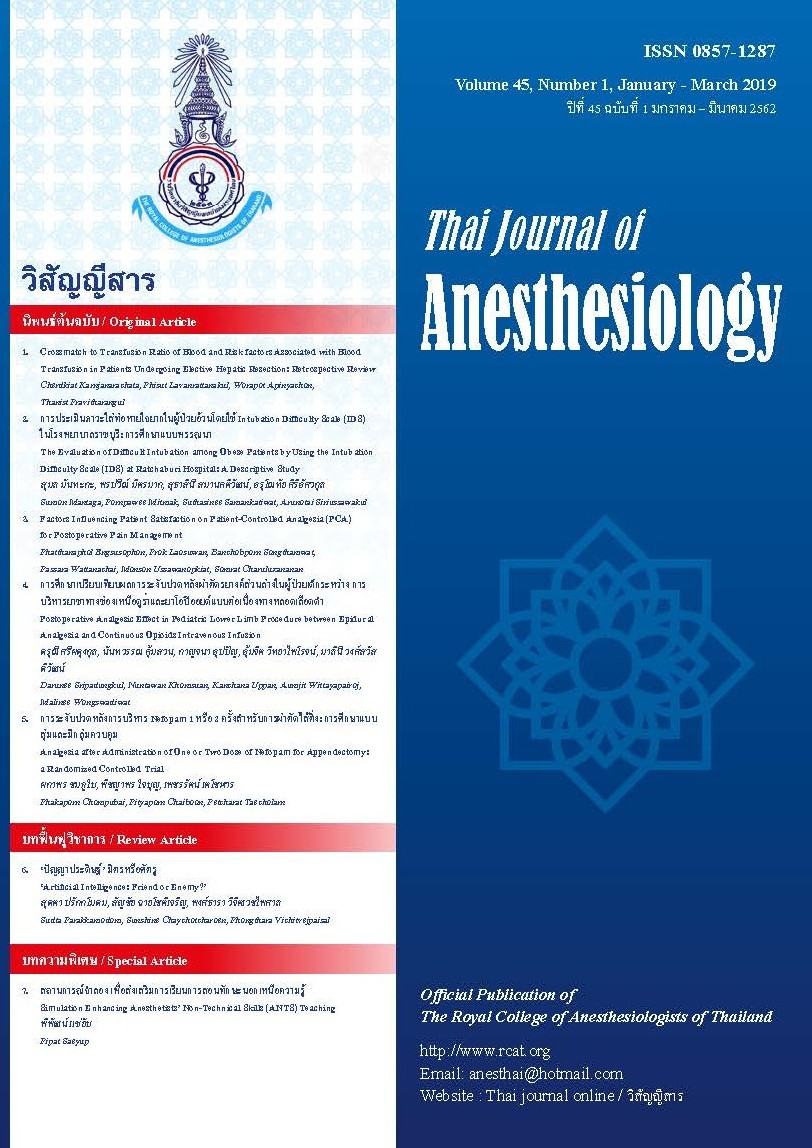Crossmatch to Transfusion Ratio of Blood and Risk factors Associated with Blood Transfusion in Patients Undergoing Elective Hepatic Resection: Retrospective Review
Main Article Content
Abstract
Background: Blood components are routinely prepared
for hepatic resection surgery, however; with current
surgical techniques, red blood cell transfusion rate is
decreasing and unnecessary crossmatch procedure is
also burden to the blood banks.
Objectives: To identify crossmatch to transfusion ratio
(CT ratio) in the patients underwent hepatic resection.
Methods: Medical records of 322 patients who underwent
hepatic resection in Ramathibodi hospital between
January 2013 to December 2016 were retrospectively
reviewed. The CT ratio was defined by the proportion
of cross-matched unit of packed red cells (PRC) and
transfused unit of PRC either intraoperative or 24 hours
postoperative periods.
Results: Four units of PRC were prepared for the operation
in 88.50% of the patients. However, as much as 57.45%
of the patients did not receive any PRC transfusion.
The calculated CT ratio of hepatectomy was 3.36 for
intraoperative and 24 hours postoperative transfusion. The
independent risk factors for intraoperative and 24 hours
postoperative transfusion are right lobectomy operation
(OR 5.64, 95%CI 2.37–13.39), wedge hepatectomy more
than or equal to 3 lesions (OR 2.73, 95%CI 1.19-6.30),
preoperative hematocrit ≤ 34% (OR 4.13, 95%CI 1.82-
9.42), and preoperative INR ≥ 1.1 (OR 2.79, 95%CI
1.56-4.98).
Conclusions: This study found that the CT ratio was 3.36.
This high CT ratio means the prepared PRC for operation
is much more than required. Right lobectomy, wedge
hepatectomy more than 3 lesions, preoperative anemia,
and coagulopathy were independent risk factors for blood
transfusion in hepatic resection.
Article Details
References
Medicine. In: Barash P, editor. Clinical Anesthesia. 7th ed.
Philadelphia, PA: Wolters Kluwer Health; 2013.p.408-44.
2. Ejaz A, Frank SM, Spolverato G, Mavros M, Kim Y, Pawlik
TM. Variation in the use of type and crossmatch blood
ordering among patients undergoing hepatic and
pancreatic resections. Surgery 2016;159:908-18.
3. Cockbain AJ, Masudi T, Lodge JP, Toogood GJ, Prasad KR.
Predictors of blood transfusion requirement in elective liver
resection. HPB (Oxford) 2010;12:50-5.
4. Pulitanò C, Arru M, Bellio L, Rossini S, Ferla G, Aldrighetti L.
A risk score for predicting perioperative blood transfusion in
liver surgery. Br J Surg 2007;94:860-5.
5. Subramanian A, Rangarajan K, Kumar S, Sharma V,
Farooque K, Misra MC. Reviewing the blood ordering schedule
for elective orthopedic surgeries at a level one trauma
care center. J Emerg Trauma Shock 2010;3:225-30.
6. Friedman BA. An analysis of surgical blood use in United
States hospitals with application to the maximum surgical
blood order schedule. Transfusion 1979;19(3):268-78.
7. Friedman BA, Oberman HA, Chadwick AR, Kingdon KI. The
maximum surgical blood order schedule and surgical blood
use in the United States. Transfusion 1976;16:380-7.
8. Palmer T, Wahr JA, O’Reilly M, Greenfield ML. Reducing
unnecessary cross-matching: a patient-specific blood
ordering system is more accurate in predicting who will
receive a blood transfusion than the maximum blood ordering
system. Anesth Analg 2003;96:369-75.
9. Lucas DJ, Schexneider KI, Weiss M, et al. Trends and risk
factors for transfusion in hepatopancreatobiliary surgery.
J Gastrointest Surg 2014;18:719-28.


